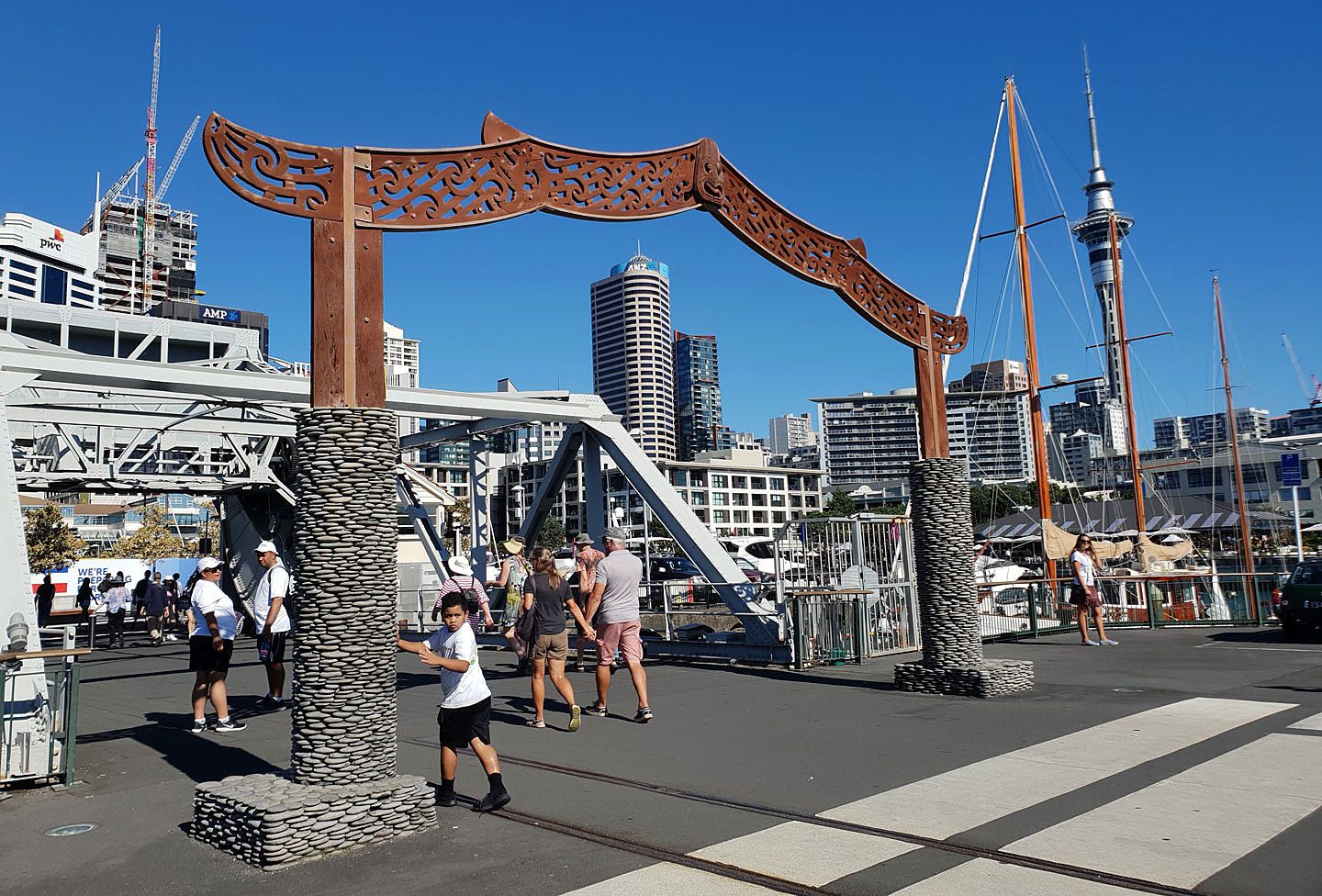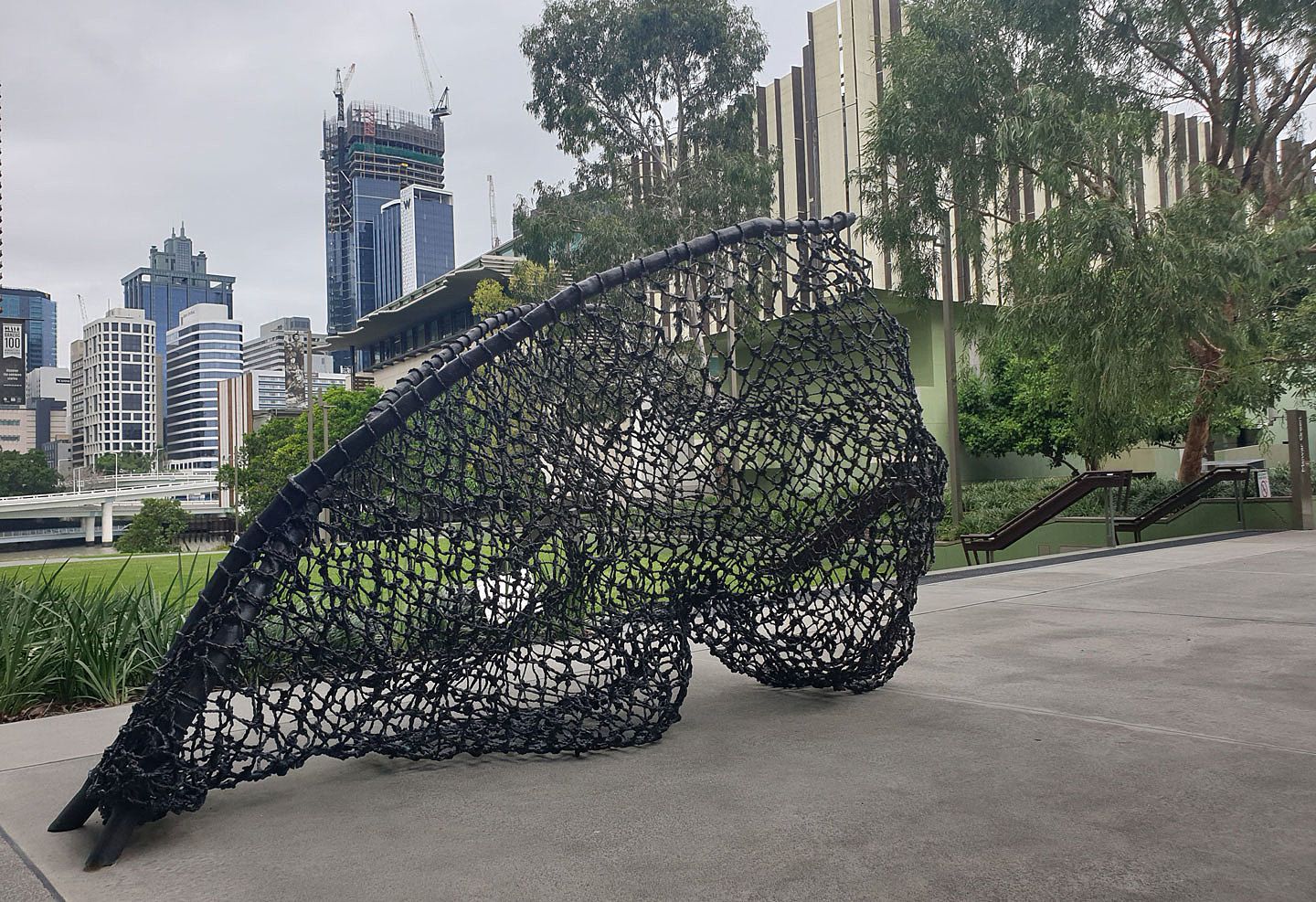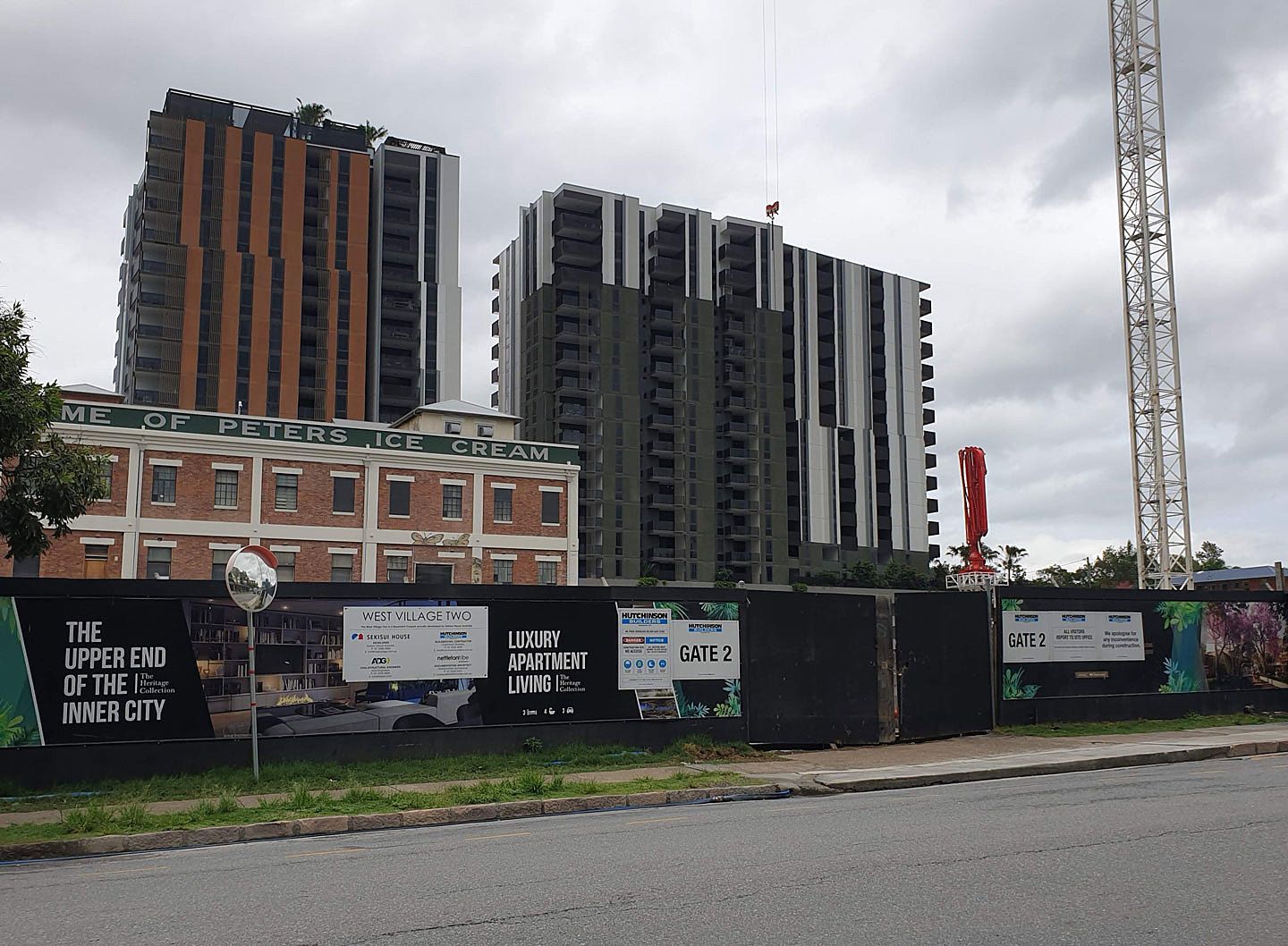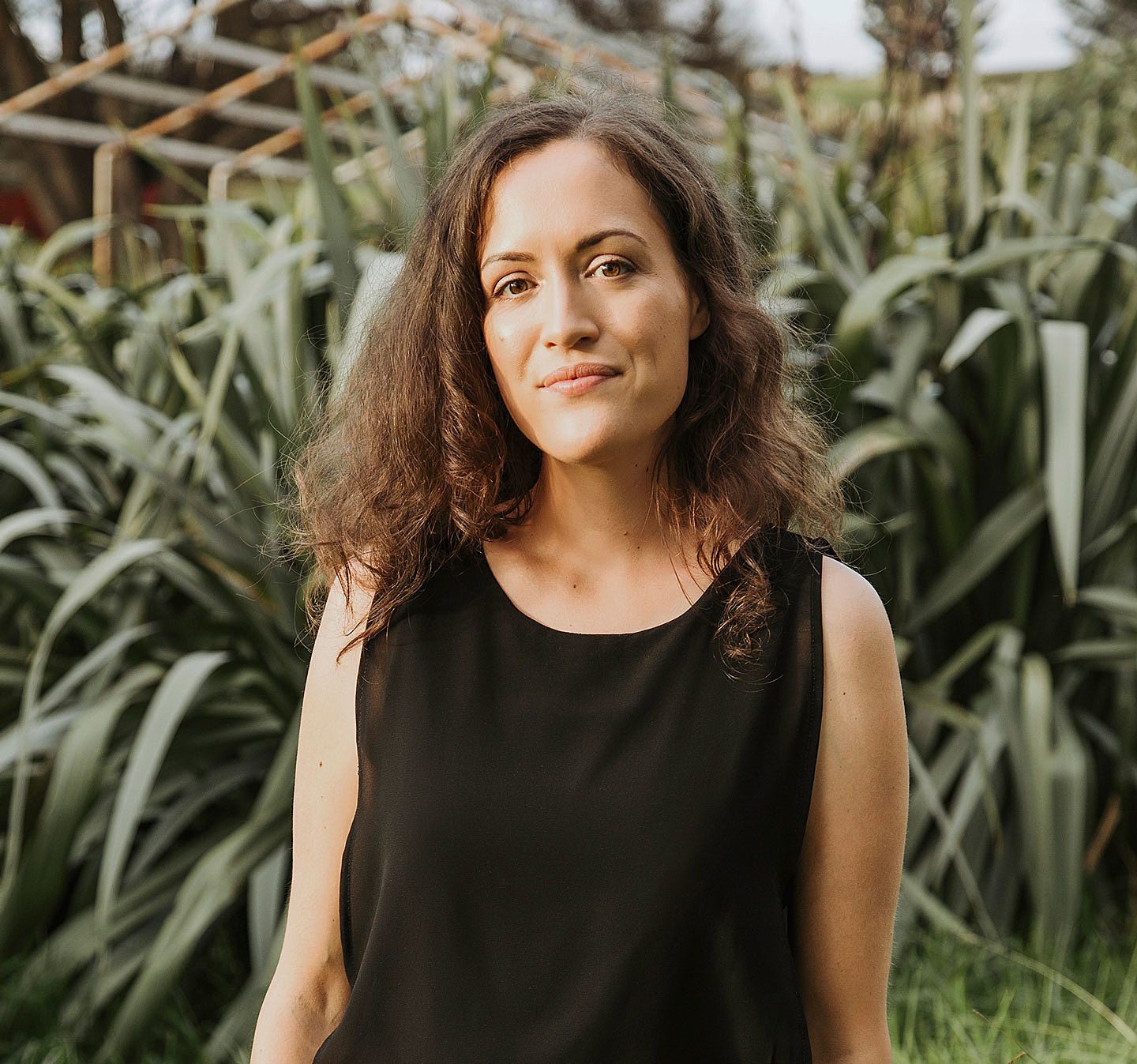Difficult Horizons: On Gentrification and Violence
Even beautiful buildings can be perpetrators of colonial violence, by act or omission.
Even beautiful buildings can be perpetrators of colonial violence, by act or omission.
Brisbane makes me feel like I’m drowning, and maybe it has always felt like this. I haven’t returned to the city in a long time. I say the city, but really I mean that triangle in the inner city connected by three primary points of interest – West End, the bohemian inner-city neighbourhood where I lived and worked from 2006 to 2012 (at the time not yet gentrified but showing early signs), the South Bank Cultural Precinct (art galleries, museums and concert halls, located directly opposite the city), and St Lucia, the university campus located just across the river. The triangle where I lived my life for six years, walking over the same paths and trails, occupying the same spaces, like a biro wearing deep grooves into lined paper by repetition.
I use the GPS app on my phone to navigate my way from the airport. I’m disoriented for much of the trip. None of the suburbs look familiar, and the colonial names confuse and confound, intertwined with the name of suburbs and streets in other cities, more recently traversed. Many of the suburbs and street names are mirrored in Auckland City, and my internal compass spins, my mental map distorted by time – yes – but also the existence of a colonial planning history shared across the two cities. I cross the bridge, one of the many bridges over the river. I no longer need the GPS. Here, the street names are charged with latent meaning. Boundary Street always makes me feel sick for the history of it, the line across which the city’s Indigenous people were not permitted to cross. Out of habit, I veer right at a familiar landmark, pulling the car off Boundary Street and onto Jane. I park my rental car on the street where I used to live and pay my fee at a parking meter that did not use to be there.
The hotel on the corner has changed, metamorphosed, the parking lot transformed into a bourgeois eatery. I meander along Boundary Street to where it intersects with Vulture, appraising the changes, and for the most part it seems as if the heart of the neighbourhood hasn’t changed all that much. Some of the older, established businesses are still there – the all-you-can-eat sushi buffet, King Ahiram (my favourite Lebanese place) and Indian Kitchen. But I find it harder to identify what is missing. The cafés all serve Banh Mi, advertised on chalk specials boards, and it seems like an almost desperate tribute to the neighbourhood’s rapidly diminishing Vietnamese population. I count three micro-breweries, and I’m reminded of Kingsland in Tāmaki Makaurau, which now houses a similar number. I wonder, wryly, what stage of late capitalism is this?
Even beautiful buildings can be perpetuators of colonial violence, by act or omission
After I’ve seen all that I need to see here, filled up with equal parts familiarity and difference, I change course and walk north-east, in the direction of the city. Half-way there I stop and gape at a park that has been clawed out of the urban fabric. It covers two-thirds of the city block. The shops and buildings either side are recognisable, but I find it difficult to recall what had been here before. Two towers loom in the distance. I lose count, but I estimate that they’re probably both close to 20 storeys tall. The park – most likely conceived as a result of planning ordinances to compensate for plot-to-area ratios, to prevent shadowing and to provide community amenity – somehow makes the scale of the tower more overwhelming, providing an uncharacteristically lush foreground and setting the towers into sharp relief. On the Mollison Street side, they’re even more stark, jutting out above hoardings advertising luxury apartment living.
I vaguely remember the debate here in Brisbane, years back, before the intensification began. Clearly those opposed to lifting the height restrictions lost the battle. In Tāmaki Makaurau, the tension between the need for development and the need to retain the character of the city’s various neighbourhoods played out during the Unitary Plan hearings. Somehow the need to retain affordability and protect those least able to resist these changes were lost in the process. I remember speaking at the hearings to strengthen the affordability provisions – a kind of inclusionary zoning that, in my view, did not go far enough – only to see these stripped through the democratic process.
I walk the remaining five blocks to the cultural centre. I am greeted by the harsh but beloved brutalist buildings of the 1970s, and the newer, more sensitive later additions – the State Library and the Gallery of Modern Art, both constructed while I was a student at the university here in the mid-2000s. Both buildings were formative in my architectural education. Although I still marvel at the planning and form, I wonder what the underlying narrative might be and how these connect to history and Indigenous conceptions of place. Even beautiful buildings can be perpetuators of colonial violence, by act or omission. In Tāmaki Makaurau, the Auckland Art Gallery Toi o Tāmaki acknowledges its context and manages to find an intersection between mana whenua and colonial histories. Perhaps it is still too subtle.
On the South Bank of the Brisbane River, a bronze sculpture by Waanyi artist Judy Watson sits outside the gallery, depicting the kind of woven fishing net that would have been used by the local Aboriginal people on the Brisbane River. In Tāmaki, I’ve been monitoring the city for changes, visiting the squares and parks and plazas, watching the proliferation of public art and narratives. The landscape is changing, shifting, in a visual language that I can understand. Both the economic angle and tourism imperative are compelling, and whilst the stories we tell others are important, more important, in my view, are the stories we tell ourselves. If and how we see ourselves in the environment matters. Connecting through histories and whakapapa, recognising who we are, who we were, who we are becoming. Sometimes, this means the uncomfortable task of facing up to our colonial history and current reality, a wound that has not and will not heal without significantly shifting the balance of power.
The sign at the entrance of the Gallery of Modern Art acknowledges the Turrbal and Jagera peoples, and I’m ashamed at how little recognition these names register. I wander around the exhibits, catching the final few weeks of the Asia-Pacific Triennial, quite by chance. Frequently I feel overwhelmed by emotion, and not for the first time I wonder if perhaps this is why people visit art galleries. Does this feeling translate into action or is enough to be overwhelmed? Vincent Namatjira’s series of three stacked rows of portraits has that effect. The top row is the seven most recent Australian Prime Ministers, the second row is seven tribal leaders from the artist’s own community, and the third row is Australia’s seven richest people. The contrast is stark and debilitating, a self-evident and painful truth.
The river that determines and structures the city. I wonder if any fish could possibly survive here
As I walked through West End, I noticed Indigenous people gathered in the same places I remember, although the buildings and spaces have changed these gathering places remain the same. Shame-faced, I wonder that I never thought to ask about the significance of these places. Without knowing, without asking, I think of the places that are significant to us, and how little control we have over them, even now in the era of the Resource Management Act and Treaty of Waitangi settlements, and I feel pōuri and māuiui at the same time. At the ferry terminal adjacent to the galleries, I look down at the brown, murky Brisbane River. The river that determines and structures the city. I wonder if any fish could possibly survive here.
Aboard the ferry, I watch the city towers give way to stacked palatial mansions lined up along the river’s edge, impossibly vast, each with their own private jetty, and wonder, who gave them permission to occupy this prime position, to dominate this space? What was lost or destroyed to enable this to happen? I feel pōuri all over again, for reasons I can’t fully explain. At home, I often find myself walking alongside marinas and boat sheds and homes perched on the waterfront, and wondering what price was paid for the privilege, and by whom? Rāhui have helped replenish kai moana beds and spawning sites, but in many places the dredging of harbours and clearance of mangroves has transformed the marine ecosystem beyond recognition.
When I arrive at the university, I follow the same familiar path past the lake to the architecture school. I enter the Zelman Cowen Building without drawing attention to myself and descend the stairs to the lower level. The artwork in the stairwell has changed, and I marvel at the map of Indigenous sites across the university campus and surrounds, printed on two sheets of ply. Tu-wong. Nyinduru-pili. Dharra-nga. The correction and decolonisation of familiar place names makes me want to cry. I think of what this has meant for us in Aotearoa – not only in the correction (Parikaha in Whangārei is a notable example for me personally), but also in the correct pronunciation (well, almost correct – I sometimes catch my partner’s son, who attends kura kaupapa, mocking the radio announcers as their tongues inexpertly stumble over our vowels, butchering our reo).
I want to discuss this with someone, I want to know who created this, when and how. I want to know if the recognition is more widespread, and if this is making any difference. I creep up the stairs to the Aboriginal Environments Research Centre, and even though this is now my area of professional expertise, I know no one here. I hover outside the door, then and now, too whakamā to enter. I think of what the mass education of our people has meant, the growing numbers of young Māori architects in Aotearoa, and how this – and the advent of Treaty settlements, among other advances – has shifted the dominant discourse in our discipline. First, carving out a niche, that became a deep groove, and now a river that threatens to engulf and replace the colonial and elitist tradition of our discipline, at least on our islands.
On the walk back towards the ferry terminal, the Bush Tucker Garden – meticulously labelled – is a welcome addition to the campus grounds. The signage identifies five categories – medicinal, edible, bird attracting, butterfly attracting and manufacturing. I recognise some of the plants and I’m curious, eager to know more. I wonder whether this new respectability afforded to Indigenous knowledge really, finally, means the beginning of reparations, or if it’s merely a new form of colonial expansion and commodification. I think of the reinstatement of our rongoā. I’m far from knowledgeable, but back at home I have been learning about our Indigenous plants and their uses, how to identify native species and how to reinstate the practices of our tūpuna. Suddenly it starts to rain, in hot, thick drops, and I’m wistful that I won’t have time to linger. I run to the ferry terminal, seeking shelter.
When a stranger asks me a question – the only person who speaks to me – I mask my accent and speak in my best white professional voice
I travel one stop on the ferry, across to the other side, and at Orleigh Park terminal I transfer to a bus. On the bus ride, I find myself picking out the visibly brown and Indigenous faces, giving in to an old and familiar impulse, wondering how I am perceived, wondering if I pass. How well I pass. I shrink into anonymity, avoiding attention. I think about how I can draw the least attention to myself, and in retrospect I wonder if I always did this. When a stranger asks me a question – the only person who speaks to me – I mask my accent and speak in my best white professional voice, even as I form a brief, affirmative response. It’s almost automatic. Doing so used to make me self-conscious, but it doesn’t now. This is, after all, the city where I first learnt to code switch.
In Aotearoa, I feel this much less, in spaces filled with safety and shared whakapapa and experience. Even as I acknowledge this, I’m aware that I have curated my own experience carefully, seeking out Māori and Indigenous spaces, dodging other realities. When I’m occasionally confronted by majority Pākehā spaces, I’m on edge, this overwhelming whiteness dangerous and exhausting even in its more benign forms. Fortunately, I never have to linger there long, not now, not anymore.
As the City Glider hurtles down Montague Road, I am once again overwhelmed by the scale of development. Although many of the wholesale warehouses remain, this part of the suburb has changed almost beyond recognition and is now filled with high-rise apartments. As I alight from the bus, I am confronted by two new towers at the end of Jane Street. It’s not that the towers are ugly, per se, but they represent the kind of change that happens to people without their consent. It seems unlikely to me that West End’s residents could afford to live here. From here, I can also see the top of my old apartment block. It’s ugly as sin, depressing un-rendered yellow brick, in three unremarkable uniform three-storey walk-ups, but I feel oddly comforted by its enduring presence, and the sharp juxtaposition. I wonder if the Queensland Department of Housing has plans to redevelop and whether it will still be here the next time I return.
As I look up at towers, new and familiar, once again I think about Auckland’s complex problems. I think about the redevelopment efforts led by Housing New Zealand Corporation and their development subsidiary, HLC (Homes Land Community). I think about the fine line between regeneration and gentrification, and how closely these seem to relate to colonisation. So many things seem to happen that are beyond our control, and as someone who holds responsibility for shaping the physical environment – however small – it’s perhaps contradictory that I am so resistant to change. Or perhaps this is unsurprising. These rapidly proliferating changes serve as a reminder that most of us are powerless and small and that, increasingly, the power to initiate change is held by a small minority.
Once again, I think, urban planning is a manifestation of power, and that even well-designed and well-intentioned architecture can be violent.



